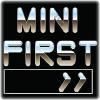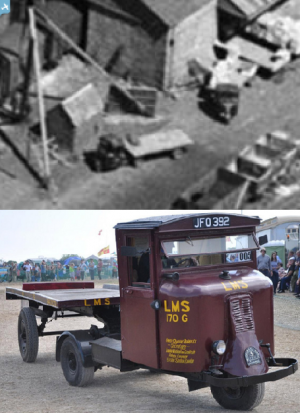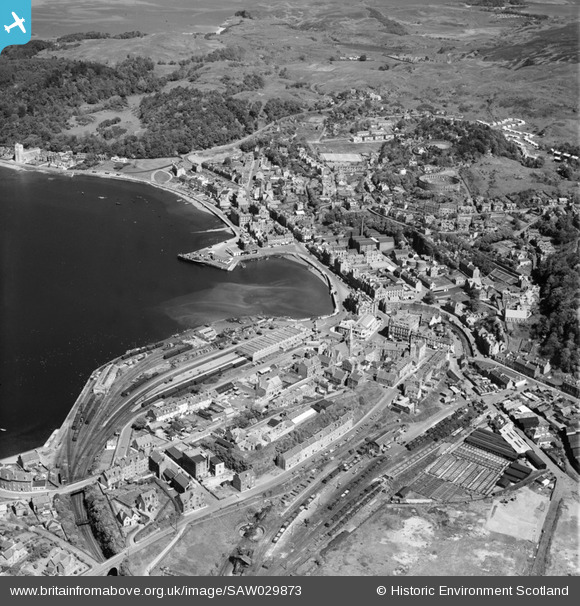 McCaig's Tower |

Billy Turner |
Sunday 13th of March 2016 08:08:58 PM |
 Oban Hotel, later Oban Inn now sadly closed with the neglected building falling into disrepair. Authorities should be ashamed of themselves. |

Billy Turner |
Sunday 13th of March 2016 07:56:13 PM |
  Scammell Mechanical Horse
Two of them in fact...
The concept of the Mechanical Horse tractor unit with an easily detached articulated trailer was conceived in the early 1930s by Napier & Son. The London and North Eastern Railway had approached Napier's, the quality car and aero-engine makers for an answer to the problem of replacing horses for local haulage purposes, while retaining the flexibility of changing the wagons and the manoeuvrability of the horse and wagon.
In 1933 Scammell Lorries Ltd purchased the three wheeled tractor unit design from the Napier Company and promptly turned it into the famous “Mechanical Horse”.
Production of the 3-wheeled Mechanical Horse commenced in 1934. The design had been refined in 1933 by Oliver Danson North, who modified the original prototype. This featured automatic trailer coupling and the single front wheel could be steered through 360 degrees. This was a very simple and sturdy vehicle which was constructed on a steel channel frame and fitted with a wooden cab, the early versions having canvas doors. The Mechanical Horse came in two sizes, capable of carrying loads of three tons and six tons, each of the two sizes had a corresponding coupling size, which became known as the 3 ton and the 6 ton coupling. The tractor units were powered by Scammell's own side valve petrol engine of 1125cc in the 3 ton version and 2043cc in the larger 6 tonner. The engine was offset to the left of the cab, which could cause stability problems in some circumstances. The vehicles had manoeuvrability which was unmatched; it was possible to turn through 360 degrees in under 20 feet with a 16-foot trailer. The road speed of about 20 mph suited the vehicle to local deliveries, and fuel consumption of 10 to 20 mpg was acceptable. Railway companies were the primary customers for the Mechanical Horse, they were also used by quite a number of private companies particularly breweries who valued the nimble little lorries. The British armed forces used them in stores and on aircraft carriers. The 6-ton coupling equipment was also fitted to popular makes of lorry such as Bedford, Thornycroft and Austin. Bedford tractor units so equipped were sold under the ‘Bedford-Scammell’ brand. Such was the popularity and success of the Mechanical Horse that there was a separate sales department using dealers for this unique machine. During the difficult trading years of the 1930s the threewheeler was the saviour of Scammell Lorries Ltd. |

Billy Turner |
Sunday 13th of March 2016 07:19:59 PM |
 Sheep and cattle pens |

MB |
Wednesday 12th of November 2014 11:45:04 AM |
 Cattle trucks |

MB |
Wednesday 12th of November 2014 11:44:33 AM |
 Coal trucks |

MB |
Wednesday 12th of November 2014 11:44:06 AM |
 Lochinvar. |

ewnmcg |
Wednesday 12th of November 2014 11:20:41 AM |
 Columba Hotel |

Billy Turner |
Tuesday 11th of November 2014 11:35:58 PM |










![[SAW029873] Oban, general view, showing Oban Bay and McCaig's Tower. An oblique aerial photograph taken facing north.](http://britainfromabove.org.uk/sites/all/libraries/aerofilms-images/public/100x100/SAW/029/SAW029873.jpg)
![[SAW022624] Oban, general view, showing North Pier and Barra Mor. An oblique aerial photograph taken facing north.](http://britainfromabove.org.uk/sites/all/libraries/aerofilms-images/public/100x100/SAW/022/SAW022624.jpg)
![[SAW022616] Oban, general view, showing Royal Hotel, Argyll Square and McCaig's Tower. An oblique aerial photograph taken facing north-east.](http://britainfromabove.org.uk/sites/all/libraries/aerofilms-images/public/100x100/SAW/022/SAW022616.jpg)
![[SAW022611] Oban, general view, showing Royal Hotel, Argyll Square and Oban Free High Church, Rockfield Road. An oblique aerial photograph taken facing east.](http://britainfromabove.org.uk/sites/all/libraries/aerofilms-images/public/100x100/SAW/022/SAW022611.jpg)
![[SAW022612] Oban, general view, showing Royal Hotel, Argyll Square and Oban Free High Church, Rockfield Road. An oblique aerial photograph taken facing east.](http://britainfromabove.org.uk/sites/all/libraries/aerofilms-images/public/100x100/SAW/022/SAW022612.jpg)
![[SAW022613] Oban, general view, showing Royal Hotel, Argyll Square and Oban Free High Church, Rockfield Road. An oblique aerial photograph taken facing east.](http://britainfromabove.org.uk/sites/all/libraries/aerofilms-images/public/100x100/SAW/022/SAW022613.jpg)
![[SAW022614] Oban, general view, showing Royal Hotel, Argyll Square and Oban Free High Church, Rockfield Road. An oblique aerial photograph taken facing east.](http://britainfromabove.org.uk/sites/all/libraries/aerofilms-images/public/100x100/SAW/022/SAW022614.jpg)
![[SAW022617] Oban, general view, showing Royal Hotel, Argyll Square and Oban Free High Church, Rockfield Road. An oblique aerial photograph taken facing east.](http://britainfromabove.org.uk/sites/all/libraries/aerofilms-images/public/100x100/SAW/022/SAW022617.jpg)
![[SAW022618] Oban, general view, showing Royal Hotel, Argyll Square and Station Hotel, George Street. An oblique aerial photograph taken facing north-east.](http://britainfromabove.org.uk/sites/all/libraries/aerofilms-images/public/100x100/SAW/022/SAW022618.jpg)
![[SAW022632] Oban, general view, showing Railway Quay and Oban Free High Church, Rockfield Road. An oblique aerial photograph taken facing east.](http://britainfromabove.org.uk/sites/all/libraries/aerofilms-images/public/100x100/SAW/022/SAW022632.jpg)
![[SAW022628] Oban, general view, showing North Pier and McCaig's Tower. An oblique aerial photograph taken facing east.](http://britainfromabove.org.uk/sites/all/libraries/aerofilms-images/public/100x100/SAW/022/SAW022628.jpg)
![[SAW022629] Oban, general view, showing North Pier and Railway Quay. An oblique aerial photograph taken facing south.](http://britainfromabove.org.uk/sites/all/libraries/aerofilms-images/public/100x100/SAW/022/SAW022629.jpg)
![[SAW029872] Oban, general view, showing Oban Bay and McCaig's Tower. An oblique aerial photograph taken facing north-east.](http://britainfromabove.org.uk/sites/all/libraries/aerofilms-images/public/100x100/SAW/029/SAW029872.jpg)
![[SPW022120] Oban, general view, showing North Pier and Corran Esplanade. An oblique aerial photograph taken facing east.](http://britainfromabove.org.uk/sites/all/libraries/aerofilms-images/public/100x100/SPW/022/SPW022120.jpg)
![[SPW022118] Oban, general view, showing Oban Bay and North Pier. An oblique aerial photograph taken facing east.](http://britainfromabove.org.uk/sites/all/libraries/aerofilms-images/public/100x100/SPW/022/SPW022118.jpg)
![[SPW022119] Oban, general view, showing Oban Bay and Torr a' Chip. An oblique aerial photograph taken facing north.](http://britainfromabove.org.uk/sites/all/libraries/aerofilms-images/public/100x100/SPW/022/SPW022119.jpg)
![[SAR018780] Oban Kilmore and Kilbride, Argyll, Scotland. An oblique aerial photograph taken facing North.](http://britainfromabove.org.uk/sites/all/libraries/aerofilms-images/public/100x100/SAR/018/SAR018780.jpg)
![[SAR018781] Oban Kilmore and Kilbride, Argyll, Scotland. An oblique aerial photograph taken facing East.](http://britainfromabove.org.uk/sites/all/libraries/aerofilms-images/public/100x100/SAR/018/SAR018781.jpg)
![[SAR018782] Kilmore and Kilbride, Argyll, Scotland. An oblique aerial photograph taken facing North/East.](http://britainfromabove.org.uk/sites/all/libraries/aerofilms-images/public/100x100/SAR/018/SAR018782.jpg)
![[SAR018784] Oban, Alexandra Hotel Kilmore and Kilbride, Argyll, Scotland. An oblique aerial photograph taken facing North/East.](http://britainfromabove.org.uk/sites/all/libraries/aerofilms-images/public/100x100/SAR/018/SAR018784.jpg)
![[SAR018790] Oban Kilmore and Kilbride, Argyll, Scotland. An oblique aerial photograph taken facing East. This image was marked by AeroPictorial Ltd for photo editing.](http://britainfromabove.org.uk/sites/all/libraries/aerofilms-images/public/100x100/SAR/018/SAR018790.jpg)
![[SAW022630] Oban, general view, showing North Pier and Barra Mor. An oblique aerial photograph taken facing north.](http://britainfromabove.org.uk/sites/all/libraries/aerofilms-images/public/100x100/SAW/022/SAW022630.jpg)
![[SAW029874] Oban, general view, showing McCaig's Tower and Oban Bay. An oblique aerial photograph taken facing west.](http://britainfromabove.org.uk/sites/all/libraries/aerofilms-images/public/100x100/SAW/029/SAW029874.jpg)
![[SAW022615] Oban, general view, showing Royal Hotel, Argyll Square and Old Parish Church, Crombie Street. An oblique aerial photograph taken facing south.](http://britainfromabove.org.uk/sites/all/libraries/aerofilms-images/public/100x100/SAW/022/SAW022615.jpg)
![[SAR018785] Oban, Regent Hotel, Argyll Hotel, Marine Hotel Kilmore and Kilbride, Argyll, Scotland. An oblique aerial photograph taken facing North/East. This image was marked by AeroPictorial Ltd for photo editing.](http://britainfromabove.org.uk/sites/all/libraries/aerofilms-images/public/100x100/SAR/018/SAR018785.jpg)
![[SAW022631] Oban, general view, showing McCaig's Tower and Ardconnel Road. An oblique aerial photograph taken facing south.](http://britainfromabove.org.uk/sites/all/libraries/aerofilms-images/public/100x100/SAW/022/SAW022631.jpg)
![[SPW022117] Oban, general view, showing Oban Bay and McCaig's Tower. An oblique aerial photograph taken facing south.](http://britainfromabove.org.uk/sites/all/libraries/aerofilms-images/public/100x100/SPW/022/SPW022117.jpg)

